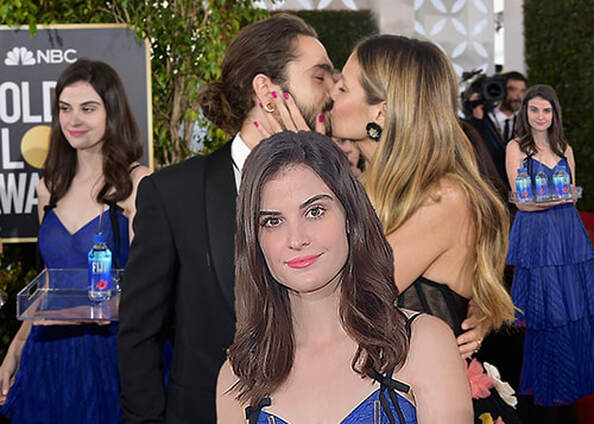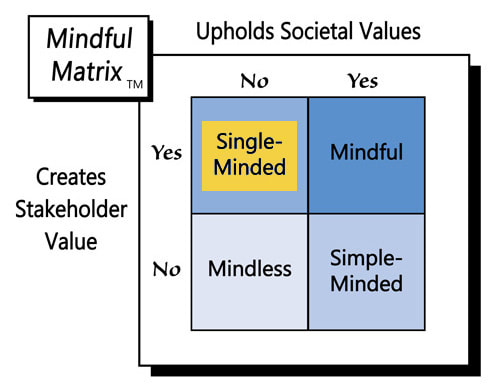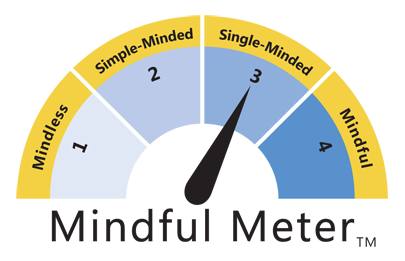Fiji Water Girl, perhaps the most famous photobomber ever, rose to global prominence in Beverly Hills, just this past weekend. Like other award programs, the Golden Globes features a preshow red carpet event during which the many talented people of television and film stroll in front of the media while slowing making their way into the Beverly Hilton Hotel.
The promenade of stars in elegant evening gowns and stylish tuxedos provides countless photo opportunities that the celebrities graciously accommodate. This time, however, as many of them posed for the paparazzi, the same, solitary figure appeared behind them: Fiji Water Girl. Her intriguing presence in the background of so many popular celebrities’ pictures ignited a social media firestorm—Who is that girl and how did she get in the images of all those icons?
For each Golden Globe awards, the Hollywood Foreign Press Association (HFPA) selects a small number of companies to be
“awards sponsors,” which means they help underwrite the cost of the program, and in return, they are permitted a demure presence at the event that includes sharing their prestige products with the program’s distinguished guests. This year’s awards sponsors were Moët & Chandon Champagne, Lavazza Coffee, Lindt Chocolates, and, of course, Fiji Water.
Fiji outfitted several young, attractive women in matching royal blue gowns, and positioned them on the red carpet, holding clear trays of the firm’s trademark bottles. Ostensibly, the idea was that thirsty guests would avail themselves of the product samples, appreciate the refreshment, and gain a positive impression of the brand. However, one particular model,
Kelleth Cuthbert, used some strategic photobombing to parlay her gig into so much more.
As mentioned above, Cuthbert somehow managed to place herself in the background of photos of a variety of top celebrities including Jim Carrey, Idris Elba, Judy Greer, Eric Lange, and Tony Shalhoub, often making “direct – and sultry – eye contact with the camera.” Social media shares of the pics quickly made Fiji Water Girl one of the web’s hottest trending topics and, according to Apex Marketing, earned Fiji about $12 million in free media exposure.
So, the $12 million question is: Was Cuthbert’s photobombing serendipitous, or was it planned?
Fiji seemed surprised by all the attention, suggesting that although it appreciated the extra exposure, it hadn’t tried to orchestrate it. The company tweeted: "We're so glad everyone is talking about our water! *senses ominous presence* She's right behind us, isn't she? #FIJIwatergirl.”
It’s also worth noting that of the several Fiji Water girls stationed on the red carpet at the Globes, Cuthbert was the only one whose presence went viral. If Fiji truly had been trying to gain mass media attention, wouldn’t more of its models have been found photobombing celebs?
All the above makes it seem like Cuthbert may have ‘gone rogue’ and taken up the photobombing herself. Since her meteoric rise to stardom, the model has had several opportunities to address such claims. She’s often suggested that her presence in so many celebrities’ pics was unplanned, for instance:
“There’s tons of photographers everywhere. It doesn’t matter where you stand, you’re in the crossfire of every shot.”
“No matter where you move, you’re in somebody’s shot. I don’t know, you just have to look at what you’re doing and be aware of where everyone is. But know that you can’t avoid it.”
“I don’t even think there was a point where I made any conscious decision [to lean into the photography]. I think from so many years of modeling, when I hear a shutter, I just kind of give a face.”
On the other hand, Cuthbert told a Los Angeles times reporter that “It’s all strategic” and “You’ve got to angle.” She also hasn’t shied away from the cameras since the Golden Globes, appearing on Inside Edition to describe her photobombing experience, taping her own mock award acceptance speech for YouTube, and making a cameo on the Late Show with James Corden.
Not having been there or spoken with Cuthbert, it’s hard to evaluate her somewhat conflicting statements and other disparate evidence. One person who was at the last Golden Globes and has many years of experience with paparazzi is accomplished film actress Jamie Lee Curtis . She expressed clear and strong sentiments about what happened to her on the red carpet:
“I specifically moved away from the blatant promotions by Fiji and Moet where young women with their trays filled with their wares stood near a designated camera. I knew why there was a photographer poised there and I moved away as I said out loud that I didn’t want to be doing advertising for either. Clearly this angle shows that I moved from her being behind me and yet from the side it still happens. The sponsors of events need to get permission from people when they get them to take their picture next to products.”
Some may suggest that Curtis overreacted to what occurred or was too cynical to think sponsors try to stage such photo ops. However, Business Insider has corroborated her claims, reporting that a specific Fiji-commissioned photographer was the initiator of the photobombing strategy.
Stefanie Keenan, the photographer contracted through Getty Images, was at the Golden Globes for the purpose of taking photos that would “elevate” Fiji, which mainly meant getting pictures of celebrities drinking the water. Cooler temperatures, however, led few stars to take the samples, so, according to Getty’s vice president of global entertainment Kirstin Benson, Keenan “came up with the idea to have a Fiji brand ambassador creep in to some shots.”
This revelation certainly supports Curtis’s experience, while contradicting many of the things that Cuthbert said. It seems, then, that the photobombing was the collaborative effort of Keenan and Cuthbert. Fiji corporate also bears responsibility in as much as it contracted with the companies that provided the photographer and the model.
But even if the photobombing was intentional, is there anything wrong with it? As mentioned at the outset of this article, it’s often funny when people photobomb others. That photobombing takes on a different meaning, though, when the pictures are used for commercial purposes.
As Curtis suggested, people, whether celebrities or ordinary citizens, have the right to choose the companies they support. You probably wouldn’t want your likeness associated with an organization whose mission you don’t endorse. You also wouldn’t want a company to profit from the use of your image without your consent.
However, that’s how Fiji unfairly benefited from the photobombing. Although the company undoubtedly paid for the privilege of being one of the few Golden Globe awards sponsors, it didn’t secure permission from or provide payment to Jamie Lee Curtis, Jim Carey, or other celebrities whose personal brands it co-opted without their consent.
Some may say that no one would assume Curtis endorses Fiji Water just because a model bearing the firm’s bottles appears behind her in a picture. A lack of an express endorsement is certainly significant; however, simply showing Curtis and Fiji together starts to establish a connection in people’s minds, especially when the picture keeps reappearing. Branding often leverages such repeat associations, as when a brand uses the same colors and fonts.
Cuthbert’s ‘performance’ on the red carpet at the Golden Globes made her and Fiji Water viral stars. They owe that celebrity status, however, to the real stars whose painstakingly-developed personal brands Fiji and company commandeered. Hopefully photobombing people with commercial content won’t catch on, as it’s clearly a picture of “Single-Minded Marketing.”
Learn more about the Mindful Matrix and Mindful Meter.
Check out Mindful Marketing Ads and Vote your Mind!




 RSS Feed
RSS Feed